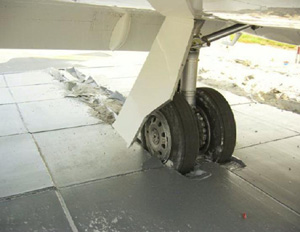The examples and perspective in this article deal primarily with the United States and do not represent a worldwide view of the subject. (February 2018) |

An engineered materials arrestor system, engineered materials arresting system (EMAS), or arrester bed[1] is a bed of engineered materials built at the end of a runway to reduce the severity of the consequences of a runway excursion. Engineered materials are defined in FAA Advisory Circular No 150/5220-22B as "high energy absorbing materials of selected strength, which will reliably and predictably crush under the weight of an aircraft". While the current technology involves lightweight, crushable concrete blocks, any material that has been approved to meet the FAA Advisory Circular can be used for an EMAS. The purpose of an EMAS is to stop an aircraft overrun with no human injury and minimal aircraft damage. The aircraft is slowed by the loss of energy required to crush the EMAS material. An EMAS is similar in concept to the runaway truck ramp or race circuit gravel trap, made of gravel or sand. It is intended to stop an aircraft that has overshot a runway when there is an insufficient free space for a standard runway safety area (RSA). Multiple patents have been issued on the construction and design on the materials and process.

FAA Advisory Circular 150/5220-22B explains that an EMAS may not be effective for incidents involving aircraft of less than 11,000 kilograms (25,000 lb) weight.[2] It also clarifies that an EMAS is not the same as a stopway, which is defined in FAA Advisory Circular 150/5300-13A, Section 312.[3] Pilots are advised, if they know the airplane is going to overrun onto an EMAS installation, to maintain directional control of the aircraft and roll straight into it. By doing this, the aircraft will come to a complete stop over a short distance, regardless of the runway conditions or braking action being experienced.[4]
As of May 2017, the International Civil Aviation Organization (ICAO) has been working on developing a harmonized regulation regarding arresting systems.
Research projects completed in Europe have looked into the cost-effectiveness of EMAS. Arrestor beds have been installed at airports where the runway safety areas are below standards, and their ability to stop aircraft with minimal or no damage to the air frame and its occupants has proven to bring results far beyond the cost of installations. The latest report, "Estimated Cost-Benefit Analysis of Runway Severity Reduction Based on Actual Arrestments", shows how the money saved through the first 11 arrestments has reached a calculated total of 1.9 billion USD, thus saving more than $1 B over the estimated cost of development (R&D, all installations worldwide, maintenance and repairs reaching a total of USD 600 million). The study suggests that mitigating the consequences of runway excursions worldwide may turn out to be much more cost-effective than the current focus on reducing the already very low probability of occurrence.[5]
- ^ Boburg, Shawn (17 September 2013). "Teterboro Airport gets $1M for runway project". northjersey.com. Archived from the original on 5 May 2014. Retrieved 5 May 2014.
- ^ [1] FAA Advisory Circular 150/5220-22B (PDF)
- ^ "Archived copy" (PDF). Archived from the original (PDF) on 21 February 2015. Retrieved 20 February 2015.
{{cite web}}: CS1 maint: archived copy as title (link) FAA Advisory Circular 150/5300-13A (PDF) - ^ Freeze, Christopher; Sedin, Jeff (August 2021). "EMAS: Don't Swerve, Go Straight Ahead". www.alpa.org. Air Line Pilots Association. Retrieved 18 May 2023.
- ^ "Estimated Cost-Benefit Analysis of Runway Severity Reduction Based on Actual Arrestments" (PDF).